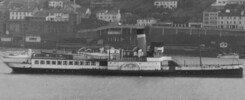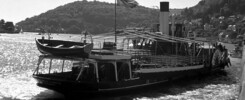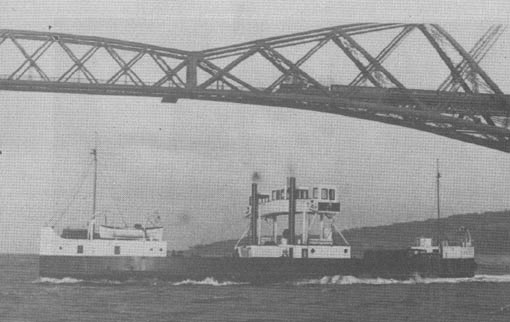
Forty years ago, in September 1964, the new Forth road bridge opened and, inevitably, the four paddle driven ferries which had maintained the crossing between North and the South Queensferry, the Queen Margaret, Robert the Bruce (pictured above), Mary Queen of Scots and Sir William Wallace, were all withdrawn.
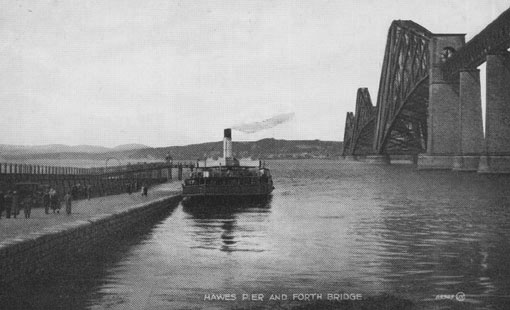
Sir William Denny thought that there was an opportunity to upgrade the ferry in the early 1930s by providing new tonnage to supplement the service then provided by the Dundee (pictured above). He approached the London and North Eastern Railway but they were not interested in putting in an order for new ships. However an agreement was reached whereby Denny would build two ships and run the ferry on behalf of the railway. This provided new and larger vessels for the crossing, business for the shipyard and also gave Denny the convenient opportunity to run an experiment to compare the logistics and costs of building two identical ships with one, the Queen Margaret of riveted and the other, the Robert the Bruce, of the then rather new technique, of all welded construction. Both were propelled by electric motors the power being provided by Diesel generators.

In 1949, another sister, Mary Queen of Scots, was built replacing the Dundee. And in 1956, a slightly larger version, Sir William Wallace, arrived which, at 159ft, was ten feet longer than her consorts. These latter two had Diesel engines turning the paddles through a hydraulic link and all four were of a rather rudimentary design with passenger facilities which could best be described as basic.
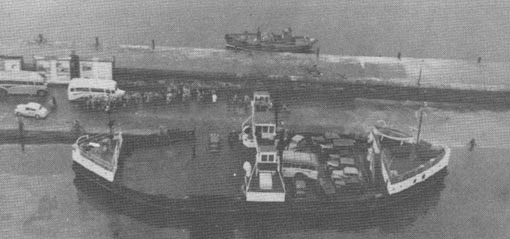
Cars and passengers were loaded using a side ramp lowered onto a permanent sloping causeway at each end of the passage as can been seen in this picture of Queen Margaret.
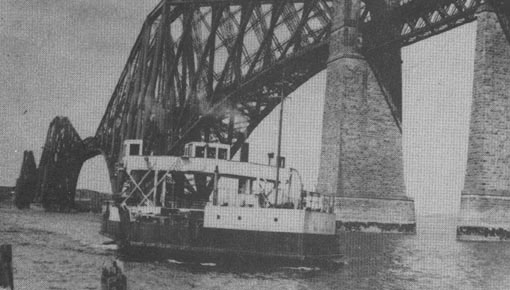
For ease of handling, the ships had a rudder at each end and independent paddle wheels which allowed their captains to occasionally indulge in their party piece of weaving in and out of the arches of the Forth Rail Bridge, an entertainment which, when viewed by representatives of the Southern Railway, persuaded them to go for a ship with such a high level of manoeuvrability for their Lymington to Yarmouth, Isle of Wight service. The Diesel electric paddle vessel Farringford of 1947 was the result.
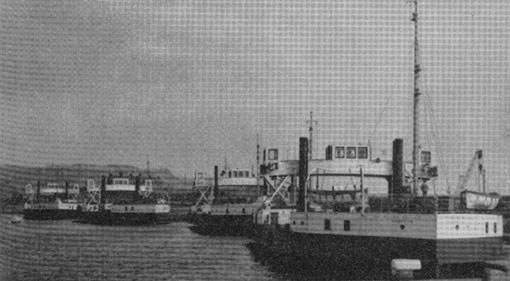
After the opening of the bridge on 4th September 1964, the four sisters were laid up at Burntisland. Queen Margaret and Mary Queen of Scots were sold for breaking by T W Ward of Inverkeithing. Robert the Bruce was broken up by P & W McLellan at Bo’ness. The Sir William Wallace had better luck. One of the last paddlers to be built in the UK and a mere spring chicken at just eight years old, she found further employment in Holland. Does anybody out there know what happened to her after that? If you do email me at info@kingswearcastle.org.
Although even their most ardent supporters could hardly have described these ships as handsome, nonetheless they were driven by paddle wheels and their withdrawal added four more names to the ever expanding list of paddlers made redundant in the 1960s.
Mr Richard Carr has written on 2nd April 2005 to say:
I worked for the diesel engine manufacturer, Paxman of Colchester, for several years and over the past few years having been putting together some history of the company. About four or five years ago I came across a reference to Paxman having supplied engines for paddle driven ferries but could find no other information or evidence to back this up. A few days ago I was looking at a 40 year old newspaper supplement which mention the names of Queen Margaret and Robert the Bruce, that they were paddle driven and were taken out of service in 1964. The page on your website with details about the builder, Denny, etc. have enabled me to trace the engine order in Paxman’s old records. Paxman supplied four 8 cylinder MZ engines to Wm Denny & Bros Ltd, Dumbarton for these paddlers (two in each) and these were despatched from Colchester on: 20-01-34; 22-01-34; 24-01-34; 25-01-34. Each engine had a rating of 175/192½ bhp at 750 rpm.
If you have an interest in one of the first British diesel-electric vessels, built by Wm Denny, you might like to have a look about one third of the way down the following page on my Paxman History website here.
Mr John Porter has written on 23rd April 2005 to say:
Have just come across this item and your request for information on the fate of Sir William Wallace. Ian Brodie, who has written a number of books on the passenger ships of the Forth, states that the ship was purchased by a Southampton shipyard and arrived there on 4th May 1965. She then sailed on to the Netherlands to carry cargo on the Ljsselmeer. Still under her original name, she was later registered in Switzerland. She was broken up at Ghent in March 1970. I am only speculating, but I think it sounds as though she was bought for some construction project and when that was done, she was scrapped.I never ever experienced a ferry going under the rail bridge. It may have happened under a combination of wind and tide but the Passenger Certificates of the three older boats was limited to above the railway bridge. Sir William Wallace could take passengers below the bridge and did so occasionally to act as a tender for a cruise ship. She also hosted a couple of late night student dances, part of Edinburgh University’s Charities Week efforts, I believe. The Wallace was 10 feet longer than the others, as you say, and 2 feet broader. This meant that she took longer to load and was marginally slower, which didn’t help the intensive 15 minute service towards the end of their time. In fact, the waiting time for a crossing could be such that it was quicker to get to Edinburgh from Fife via the Kincardine Bridge, 16 miles upstream. For those of us who learned to drive in Fife, taking the test was the first big event in one’s driving career but it was followed by a test just as tense – the first crossing on the ferry. They really packed us in tightly and every vehicle had to reverse at some point. I was quite surprised when I first crossed at Woolwich to find how much space was allowed between vehicles. When the four boat 15 minute service started, a second slip was used on the north side and both sides of the Hawes pier on the south side. Since loading was always on the west side of the boat at North Queensferry, and could be on either side at South Queensferry, it occasionally happened that, when cars tried to leave on the other side from which they had loaded, they were so tightly packed that no one could move. The solution adopted was to lower the ramp on the off-side over the water and drive a vehicle a couple of feet on to it to create space. This came to an end when a minister mistook his instruction and drove straight off, drowning himself and his wife. There was no more of that particular dodge. I have many happy memories of my 15 minute voyages but there were many frustrations, too. As you say, the accommodation provided for foot passengers was spartan in the extreme. I doubt if it was ever used.
Robert Maxtone-Graham has written to say:
50 years ago, on 20th July 1956, friends and I chartered the Sir William Wallace for the night, and gave a dance on board for 400 guests. My fellow-hosts and I have wondered for ages what happened to the boat after the road bridge was built. I see from your website that she went to Holland, but do you know anything else?
You can read more about this in the April 2006 Pictures of the Month here.
Kingswear Castle returned to service in 2023 after the first part of a major rebuild which is designed to set her up for the next 25 years running on the River Dart. The Paddle Steamer Kingswear Castle Trust is now fund raising for the second phase of the rebuild. You can read more about the rebuilds and how you can help if you can here.
John Megoran

